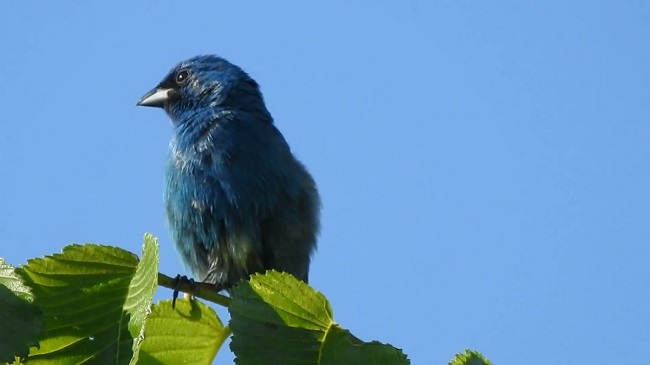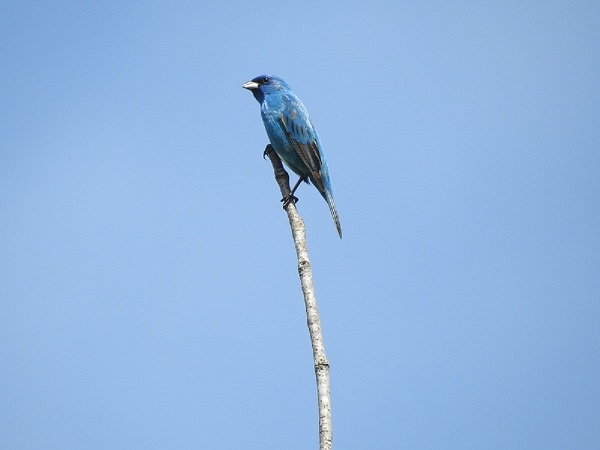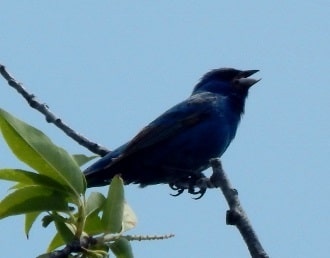Explore the Habits of the Indigo Bunting
Description: Size, Field Marks
Measuring 4 1/2 to 5 1/2 inches in length and has a sparrow-like dark gray conical bill.

Indigo Bunting in Shrub
In summer, the male is dark blue overall. In winter the male is brownish with some blue on underparts. It takes the sun's light to see the iridescent blue of this bird.
The blue appearance comes from the microscopic structure of the feathers, which scatters light in a way that makes them appear blue.
This is called structural coloration, meaning if you were to crush the feathers, they would lose their color and appear brown or gray instead of blue.
The female is a plain brown, with faint wing bars and faint streaking. Keeping this same plumage all year. Female Indigos can be difficult to find.
Their plumage and secretive nature during nesting make them difficult to add to the birder's list.
Indigo Bunting Songs and Call
One of the best ways to locate these birds is to learn the song as you'll usually hear them before seeing them.
The Song: The Indigo Bunting's song is a series of rich, melodic notes that are often described as a jumbled, warbling phrase.
It is characterized by its high-pitched, musical quality. The song consists of short, clear, and rapid notes that are delivered in a cascading manner.
The Calls:
Apart from its song, the Indigo Bunting also produces various calls. These calls serve as contact calls, alarms, or communication signals.
Chip Call: The chip call is a short, sharp "chip" or "tik" sound. It is often used for short-distance communication between individuals or as an alarm call when the bird senses potential danger.
Chatter Call: The chatter call is a series of high-pitched, rapid, and repetitive notes that sound like a buzzing or chattering sound.
This call is usually made during aggressive encounters or territorial disputes.
Flight Call: The flight call is a distinct "pseep" or "seeep" sound that the Indigo Bunting emits during flight.
It is a short, single-note call used to maintain contact with other birds during movement.
Contact Call: The contact call is a soft, high-pitched, and mellow note used by individuals to stay in touch with each other, particularly when foraging in close proximity.
Mating Habits
Not much is known about the Indigo Bunting's mating habits other than to say, singing from an uppermost perch is likely done to attract a prospective mate and protect his territory.
Nesting Habits

Male Indigo Bunting in Tree
Nest site selection is done by the female and she alone builds the nest.
The nest is a well-made cup of grass, leaves, bark strips and lined with finer grasses and downy material.
Located 5 to 15 feet above the ground in a bush, small tree, or tangle.
The female lays 3 to 4 bluish unmarked eggs. Incubation is done by the female only and lasts about 12 to 13 days.
Once hatched, the female feeds the young. The male does not feed the female and helps little with the young.
| Indigo Bunting Nesting Stats | |
|---|---|
| Eggs | 3 - 4 |
| Incubation | 12 - 13 days |
| Nestling Phase | 9- 12 days |
| Broods | 1 - 2 |
The young will leave the nest within 9 to 12 days (average) after hatching. These birds are very reluctant to approach the nest if humans are close by.
If you get near the nest they will give a "spit" call and flick their tail.
1 - 2 broods raised each year. Sometimes the male will still be feeding the first fledglings while the female begins building a second nest.
Feeding Habits
Indigo Buntings forage on the ground and in low foliage for insects such as spiders. Additional food sources for these birds include weed seeds, wild berries, and grain.
Watch The Male as He Sings
Predators
Predators of nestlings and eggs include snakes, raccoons, Blue Jays, and cats.
Migration
Indigo Buntings leave their wintering grounds and begin arriving on their breeding territories by April going through early June.
The breeding season ends by September although most nests are completed by August. Southward bunting migration occurs by October. They winter from s. Florida to n. South America.






